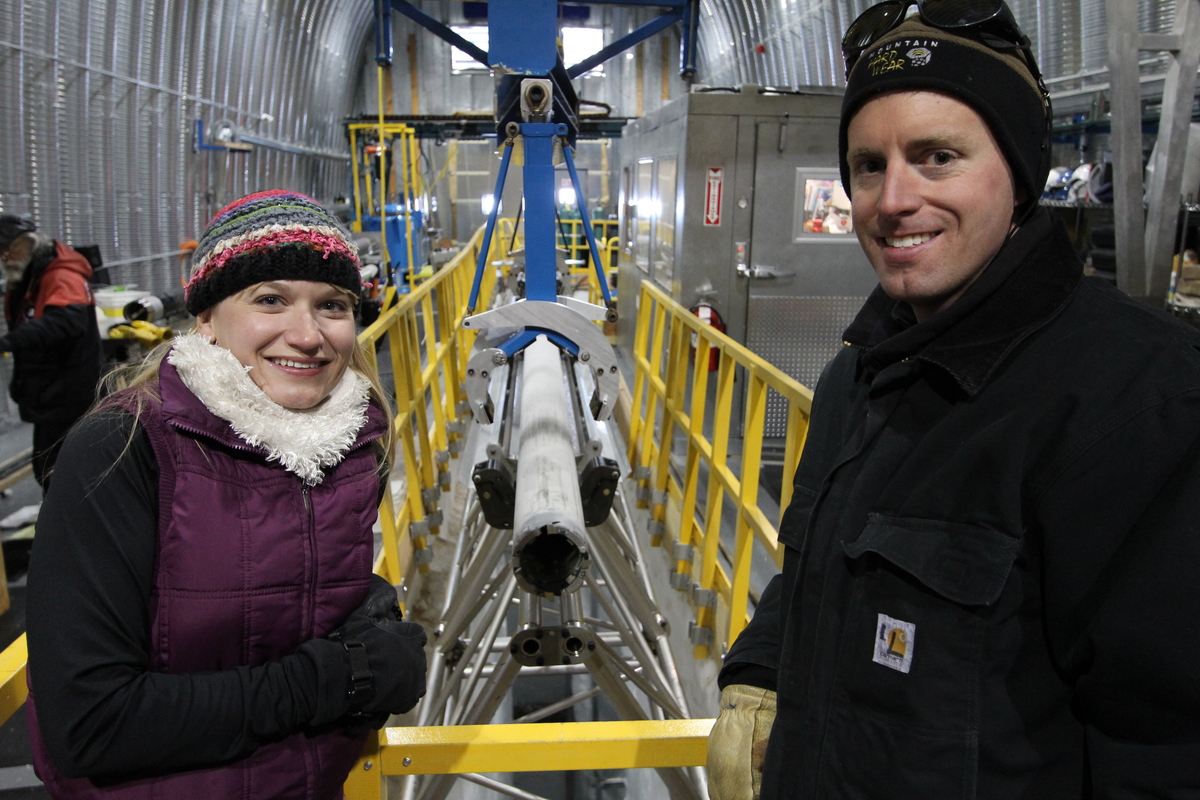They know the drill: UW leads the league in boring through ice sheets

Kristina Slawny (left) and Jay Johnson (right) stand next to the Deep Ice Sheet Coring Drill, designed and managed by the Ice Drilling Design and Operations group at the University of Wisconsin–Madison.
Photo: Jay Johnson
Wisconsin is famous for its ice fishers — the stalwarts who drill holes through lake ice in the hope of catching a winter dinner. Less well known are the state’s big-league ice drillers — specialists who design huge drills and use them to drill deep into ice in Greenland and Antarctica, places where even summer seems like winter.
The quarry at these drills includes some of the biggest catches in science.
A hot-water drill designed and built at the University of Wisconsin–Madison’s Space Science and Engineering Center (SSEC) and the Physical Sciences Laboratory was critical to the success of IceCube, a swarm of neutrino detectors at the South Pole that has opened a new frontier in astronomy.
Hollow coring drills designed and managed by UW–Madison’s Ice Drilling Design and Operations (IDDO) program are used to extract ice cores that can analyze the past atmosphere, says Shaun Marcott, an assistant professor of geoscience at UW–Madison. Marcott was the first author of a paper published today in the journal Nature documenting carbon dioxide in the atmosphere between 23,000 and 9,000 years ago, based on data from an 11,000-foot hole in Antarctica.
“Without the ice cores being as pristine as they are … we would not be able to understand how this powerful greenhouse gas has affected our planet in the past.”
Shaun Marcott
The ice drilling program traces its roots to Charles Bentley, a legendary UW–Madison glaciologist and polar expert. The program is funded by the National Science Foundation and housed in the Space Science and Engineering Center.
“Building on Charlie’s achievements, IceCube enhanced our competency of drilling expertise,” says IDDO principal investigator Mark Mulligan. “A 2000 award from the National Science Foundation brought in more engineers and technicians who understand coring and drilling.”
IDDO program director Kristina Slawny spent six austral summers on the West Antarctic Ice Sheet Divide project, which provided cores for Marcott’s climate study. “It’s an experience like no other,” she says. “We sleep in unheated single tents that get really warm in the day and quite cold at night.”
Crew compatibility is “huge,” says Slawny, “and in a remote environment we focus on it, so we’ve had really good continuity in our driller hiring. Once a group has worked together, we want them to stay. When everyone is cold and tired, they can get agitated easily, but for the most part, the crew was happy to be down there.”
Still, “everything goes wrong, even the stuff you don’t expect,” she says. “One year it’s mechanical, the next year it’s electrical. One of our staffers, Jay Johnson, is a brilliant engineer and machinist who can fix anything, but it can take long hours and sleepless nights to keep the drill running.”
Many projects under development require mobile drills, says Mulligan. “The science community has said we need a certain type of core in a certain location, but you may only be able to get there with a helicopter or small plane. That forces us to design smaller, or make something that can be set up relatively quickly. Agile and mobile are very big words.”
“We need to know how the Earth system works, but without these ice cores, and the great effort from the drilling team, we would not be in a position to know.”
Shaun Marcott
As concerns about the climatic effects of greenhouse gases mount, Marcott says deep, old ice offers a ground-truthing function. “How do you know that today’s carbon dioxide variations are even meaningful?” he asks. “We have only 50 years of instrument data.”
Climate studies require a much longer horizon, Marcott adds. “When I measure CO2 from 20,000 years ago, I actually have air from 20,000 years ago, and so I can measure the concentration of CO2 directly. There is no other way to do that.”
Much of the credit, Marcott says, is due to UW’s ace ice drillers. “Without the ice cores being as pristine as they are, without the drillers being able to take out every single core unbroken to provide us with a 70,000-year record of CO2, we would not be able to understand how this powerful greenhouse gas has affected our planet in the past.”
Today, carbon dioxide is growing at 2 parts per million per year — 20 times faster than the preindustrial situation recorded in the ice cores. But even at the slower rate, climate reacted very quickly to changing levels of the key greenhouse gas, Marcott says. “It’s not just a gradual change from an ice age to an interglacial. We need to know how the Earth system works, but without these ice cores, and the great effort from the drilling team, we would not be in a position to know.”




